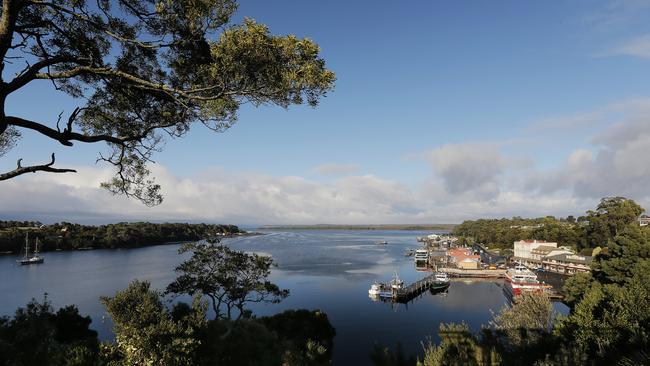Talking Point: Bring Tasmanians along for the ride
CAN SENG OOI: Find a way to build consensus and a long-term plan for tourism

Opinion
Don't miss out on the headlines from Opinion. Followed categories will be added to My News.
TASMANIA is enjoying a tourism boom. Everyone agrees that a balanced and sensitive approach to tourism development is needed. What is considered balanced and sensitive tourism development remains unclear. This ambiguity is the source of the many debates we are having.
Nobody in policymaking, business and society would disagree to balanced tourism development, but each group has its own interpretation of what it means. Each group has its own agenda and interest. If Team Tassie is to move forward together, it is time to face up to the issues.
Tourism means different things to different people. To many policymakers and politicians, tourism creates jobs and revenues. Nature and culture are magically turned into lucrative economic resources through tourism.
The accommodation sector focuses on visitor numbers and wants more attractions. Attraction operators are aware of the competition, and want to stay relevant and interesting; they do not necessarily want to have more competing attractions.
As for residents, most are welcoming but fear “touristification”. Inflation is a concern as visitors drive up demands for local resources (for example, housing). On the other hand, residents who offer short-term rentals may look forward to an exponential growth in tourist numbers. How do we bring contrasting, if not contradicting, interests together?
There are two fundamental issues to address. The goal is to find an acceptable set of compromises for most, if not all, parties.
The first issue is social change. There is a persistent view Tasmania should not change because it is already attracting visitors. Established values should be maintained. Why replace the goose that lays the golden eggs? On the other hand, it is important to welcome progress because old values may become redundant in the future.
Many coastal regions in west Denmark have attracted German tourists over the years. The beautiful beaches and quaint villages were seen as the main attractions. But the shine loses its gloss, as these Danish places are seen as tired in comparison to newly revived coastal towns in Europe. Visitors may romanticise the nostalgic but they also want new interpretations of the past.
The second issue is on consensus. While different groups have different interests, there is no consensus within each group. The democratic process of building consensus through consultation is laudable. The process however may generate even more conflicts. Building consensus with less consultation, and in a more forceful way, is frowned upon. It is however used more frequently than one might think. Soft manipulation, persuasion and coercion is commonplace in modern society; just think of advertising, branding and marketing campaigns.
Different stakeholders have different interpretations of balanced and sensitive tourism development. Not managing these different interpretations can be dangerous.
Without co-ordination and leadership, one danger is to become “market-driven” and be led by specific tourism businesses. Ad hoc projects may not result in long-term sustainable tourism growth. An extreme example is Macau. It is driven by the gambling business and catering mainly to Chinese tourists. We surely do not want a plastic fantastic Tasmania. Can we establish mechanisms to ensure we keep some values, while being brave enough to change some? Can we ensure people are consulted, yet demonstrate leadership in bringing about sustainable sensitive changes?
Tourism Tasmania is doing a good job in marketing the state. State authorities together with the peak tourism business body have set out targets and five-year plans. We have tourism businesses initiating brave projects to make Tasmania attractive. It is time to take the next big step.
What seems to be missing is a dedicated co-ordinating body that not only promotes Tasmania but also drives balanced and sustainable tourism development.
I am not a fan of co-ordination bodies. A cacophony of views is always welcome, as it reflects a healthy social political system. Today we hear of celebrated and exciting projects around the island. But how are we going to bring these attractions together, to make sure that infrastructure and amenities are available? Are we building too many similar types of accommodation? Will new attractions cannibalise older ones? How can small businesses take part in the visitor economy? Who is doing the forward thinking so Tasmania will have attractions no one has ever envisaged? Who is ensuring development stays balanced, and that the growth is sustained?
Fortunately Tasmania does not have a tourism growth problem yet. As tourism expands, these issues will become salient as more visitors come, new attractions compete and Tasmania joins the big league in global tourism competition. Just riding the wave is not going to be good enough.
One way of ensuring that Tasmania has balanced sustained tourism development is to appoint a body that can lead. The job of that independent co-ordinating body is not just in promoting the island and co-ordinating tourism projects but also in devising a sustainable plan based on strong research and long-term thinking. The body must show leadership by providing an inspiring vision that excites the industry and the community, and also pushes high-quality projects that make Tasmania thrilling, diverse and relevant to the future. Communities and their interests stay central in the plans, and the benefits of tourism must be communicated to residents.
Maybe Tourism Tasmania should have its mandate expanded. Maybe another body should be formed.
Regardless, if we want balanced and sensitive tourism development, we need an independent body to stand above narrow interests and agendas.
Tourism belongs to all.
Can Seng Ooi is professor of Cultural and Heritage Tourism and co-director of the Tourism Research and Education Network at the University of Tasmania. He is originally from Singapore and worked for 20 years at the Copenhagen Business School before moving to Hobart a year ago.


